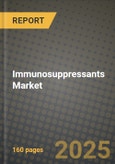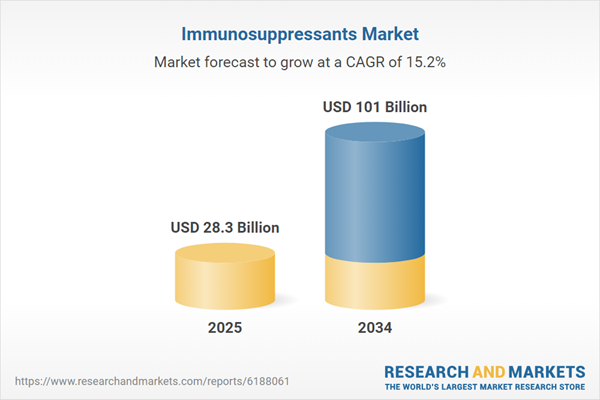The Immunosuppressants Market is critical to the treatment of autoimmune diseases, organ transplantations, and various inflammatory conditions by inhibiting the immune system’s ability to attack healthy cells. These drugs work by targeting specific components of the immune response, such as T-cells, B-cells, or cytokines, to prevent rejection of transplanted organs and to control overactive immune responses. Immunosuppressants are used to treat a wide range of diseases, including rheumatoid arthritis, lupus, multiple sclerosis, and inflammatory bowel disease. The market is driven by the increasing number of organ transplants, rising autoimmune disease prevalence, and advancements in drug formulations that improve efficacy and reduce side effects. As the global population ages and more people require chronic disease management, the demand for immunosuppressants continues to rise.
The immunosuppressants market witnessed continued growth, particularly due to the increasing number of organ transplants and advancements in biologic immunosuppressant therapies. The use of biologics, including monoclonal antibodies and cytokine inhibitors, provided more targeted immunosuppressive effects with fewer side effects compared to traditional drugs like corticosteroids and calcineurin inhibitors. Additionally, new oral immunosuppressant formulations gained traction, providing greater convenience for patients compared to intravenous treatments. The use of combination therapies, often incorporating immunosuppressants with other drug classes, was also explored in treating autoimmune diseases, particularly in cases of refractory or severe disease. Moreover, advancements in personalized medicine and biomarker-guided therapies are enabling more individualized treatment regimens that optimize outcomes and minimize adverse effects.
The immunosuppressants market is expected to evolve with innovations in biologic and gene therapy-based treatments. New monoclonal antibodies and immune cell therapies will target specific immune pathways involved in transplant rejection and autoimmune disease pathogenesis. Personalized approaches, where treatment is tailored to the individual’s genetic makeup, will become more prevalent in the management of conditions like organ transplantation and autoimmune diseases. Additionally, the rising awareness of the importance of medication adherence will drive demand for new forms of immunosuppressants, such as long-acting injectable or implantable drug delivery systems. As the need for immunosuppressive therapy in chronic conditions increases, the market will continue to grow, with a focus on improving safety, reducing side effects, and making these therapies more accessible globally.
Key Insights: Immunosuppressants Market
- Biologic immunosuppressants, such as monoclonal antibodies, are becoming more popular for their targeted action and reduced side effects compared to traditional drugs.
- Personalized medicine approaches are gaining traction, allowing immunosuppressant therapies to be tailored to an individual's genetic profile and disease characteristics.
- Oral and long-acting formulations of immunosuppressants are offering more convenient administration options for patients, increasing adherence.
- Combination therapies that include immunosuppressants with other drug classes are being explored to enhance efficacy and manage severe autoimmune diseases.
- Advances in gene therapies and cell-based therapies are opening new treatment avenues for patients with autoimmune diseases and transplant recipients.
- Increasing incidence of autoimmune diseases and the rising number of organ transplants are driving the demand for immunosuppressive treatments.
- Advances in biologic therapies are improving treatment outcomes and offering safer, more targeted alternatives to traditional immunosuppressants.
- Growing awareness of the benefits of personalized medicine is encouraging the development of tailored immunosuppressive therapies for patients.
- Government support, including funding for research and healthcare coverage for organ transplant recipients, is expanding access to immunosuppressive treatments.
- The risk of infections, cancer, and other side effects from long-term immunosuppressant use presents a significant challenge in managing therapy regimens.
- The high cost of biologic immunosuppressants and limited access to these treatments in lower-income regions remains a barrier to broader adoption.
Immunosuppressants Market Segmentation
By Drug Class
- Corticosteroids
- Monoclonal Antibodies (mAbs)
- Calcineurin Inhibitors
- mTOR Inhibitors
- Anti-Proliferative Agents
- Other Drug Classes
By Indication
- Organ Transplantation
- Autoimmune Disorders
- Non-Autoimmune Inflammatory Diseases
By Distribution Channel
- Hospital Pharmacies
- Retail Pharmacies
- Online Pharmacies
Key Companies Analysed
- Berkshire Hathaway Inc.
- Ertan Hydropower Development Company Ltd
- General Electric Company
- Sinohydro Corporation
- Mitsubishi Heavy Industries Ltd.
- Southern Company
- ABB Ltd.
- Duke Energy Corporation
- Alstom Power
- EDP Energias do Brasil SA
- Hydro-Quebec
- Alcoa Inc.
- MidAmerican Energy Holdings Company
- Ishikawajima-Harima Heavy Industries Co. Ltd.
- Andritz AG
- CPFL Energia
- China Hydroelectric Corporation
- China Yangtze Power Co. Ltd.
- Tata Power Company
- Statkraft AS
- The British Columbia Hydro and Power
- Ontario Power Generation
- RusHydro PJSC
- Acciona Energia S.A
- Voith Group
- China Three Gorges Corporation
- Portland General Electric
- Agder Energi SA
- Idaho Power Company
- Vattenfall AB
- Alaska Electric Light & Power Company
- HydroChina International Engineering Co. Ltd.
- Nepal Electricity Authority
- OJSC Bashkirenergo
Immunosuppressants Market Analytics
The report employs rigorous tools, including Porter’s Five Forces, value chain mapping, and scenario-based modeling, to assess supply-demand dynamics. Cross-sector influences from parent, derived, and substitute markets are evaluated to identify risks and opportunities. Trade and pricing analytics provide an up-to-date view of international flows, including leading exporters, importers, and regional price trends.Macroeconomic indicators, policy frameworks such as carbon pricing and energy security strategies, and evolving consumer behavior are considered in forecasting scenarios. Recent deal flows, partnerships, and technology innovations are incorporated to assess their impact on future market performance.
Immunosuppressants Market Competitive Intelligence
The competitive landscape is mapped through proprietary frameworks, profiling leading companies with details on business models, product portfolios, financial performance, and strategic initiatives. Key developments such as mergers & acquisitions, technology collaborations, investment inflows, and regional expansions are analyzed for their competitive impact. The report also identifies emerging players and innovative startups contributing to market disruption.Regional insights highlight the most promising investment destinations, regulatory landscapes, and evolving partnerships across energy and industrial corridors.
Countries Covered
- North America - Immunosuppressants market data and outlook to 2034
- United States
- Canada
- Mexico
- Europe - Immunosuppressants market data and outlook to 2034
- Germany
- United Kingdom
- France
- Italy
- Spain
- BeNeLux
- Russia
- Sweden
- Asia-Pacific - Immunosuppressants market data and outlook to 2034
- China
- Japan
- India
- South Korea
- Australia
- Indonesia
- Malaysia
- Vietnam
- Middle East and Africa - Immunosuppressants market data and outlook to 2034
- Saudi Arabia
- South Africa
- Iran
- UAE
- Egypt
- South and Central America - Immunosuppressants market data and outlook to 2034
- Brazil
- Argentina
- Chile
- Peru
Research Methodology
This study combines primary inputs from industry experts across the Immunosuppressants value chain with secondary data from associations, government publications, trade databases, and company disclosures. Proprietary modeling techniques, including data triangulation, statistical correlation, and scenario planning, are applied to deliver reliable market sizing and forecasting.Key Questions Addressed
- What is the current and forecast market size of the Immunosuppressants industry at global, regional, and country levels?
- Which types, applications, and technologies present the highest growth potential?
- How are supply chains adapting to geopolitical and economic shocks?
- What role do policy frameworks, trade flows, and sustainability targets play in shaping demand?
- Who are the leading players, and how are their strategies evolving in the face of global uncertainty?
- Which regional “hotspots” and customer segments will outpace the market, and what go-to-market and partnership models best support entry and expansion?
- Where are the most investable opportunities - across technology roadmaps, sustainability-linked innovation, and M&A - and what is the best segment to invest over the next 3-5 years?
Your Key Takeaways from the Immunosuppressants Market Report
- Global Immunosuppressants market size and growth projections (CAGR), 2024-2034
- Impact of Russia-Ukraine, Israel-Palestine, and Hamas conflicts on Immunosuppressants trade, costs, and supply chains
- Immunosuppressants market size, share, and outlook across 5 regions and 27 countries, 2023-2034
- Immunosuppressants market size, CAGR, and market share of key products, applications, and end-user verticals, 2023-2034
- Short- and long-term Immunosuppressants market trends, drivers, restraints, and opportunities
- Porter’s Five Forces analysis, technological developments, and Immunosuppressants supply chain analysis
- Immunosuppressants trade analysis, Immunosuppressants market price analysis, and Immunosuppressants supply/demand dynamics
- Profiles of 5 leading companies - overview, key strategies, financials, and products
- Latest Immunosuppressants market news and developments
Additional Support
With the purchase of this report, you will receive:- An updated PDF report and an MS Excel data workbook containing all market tables and figures for easy analysis.
- 7-day post-sale analyst support for clarifications and in-scope supplementary data, ensuring the deliverable aligns precisely with your requirements.
- Complimentary report update to incorporate the latest available data and the impact of recent market developments.
This product will be delivered within 1-3 business days.
Table of Contents
Companies Mentioned
- Berkshire Hathaway Inc.
- Ertan Hydropower Development Company Ltd.
- General Electric Company
- Sinohydro Corporation
- Mitsubishi Heavy Industries Ltd.
- Southern Company
- ABB Ltd.
- Duke Energy Corporation
- Alstom Power
- EDP Energias do Brasil SA
- Hydro-Quebec
- Alcoa Inc.
- MidAmerican Energy Holdings Company
- Ishikawajima-Harima Heavy Industries Co. Ltd.
- Andritz AG
- CPFL Energia
- China Hydroelectric Corporation
- China Yangtze Power Co. Ltd.
- Tata Power Company
- Statkraft AS
- The British Columbia Hydro and Power
- Ontario Power Generation
- RusHydro PJSC
- Acciona Energia S.A
- Voith Group
- China Three Gorges Corporation
- Portland General Electric
- Agder Energi SA
- Idaho Power Company
- Vattenfall AB
- Alaska Electric Light & Power Company
- HydroChina International Engineering Co. Ltd.
- Nepal Electricity Authority
- OJSC Bashkirenergo
Table Information
| Report Attribute | Details |
|---|---|
| No. of Pages | 160 |
| Published | October 2025 |
| Forecast Period | 2025 - 2034 |
| Estimated Market Value ( USD | $ 28.3 Billion |
| Forecasted Market Value ( USD | $ 101 Billion |
| Compound Annual Growth Rate | 15.1% |
| Regions Covered | Global |
| No. of Companies Mentioned | 34 |









